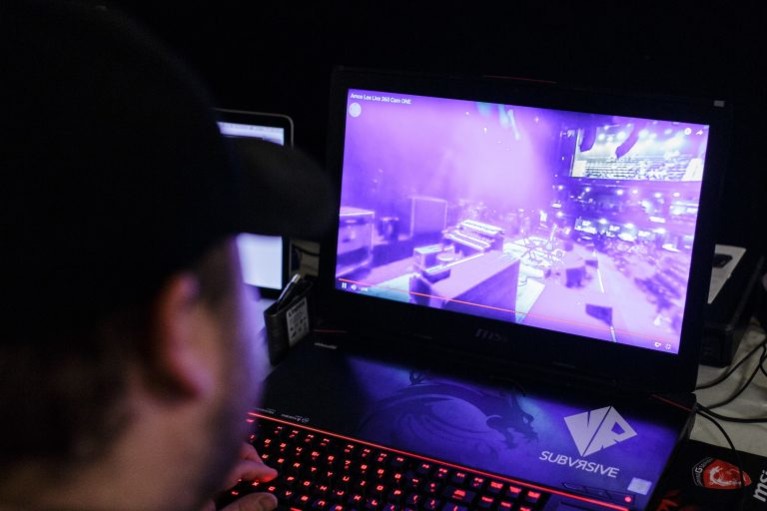Streaming music to hospitalized children in multi-360 virtual reality
Philadelphia-based singer-songwriter Amos Lee played a sold-out concert at the world-renowned Austin City Limits Moody Theater on Saturday, February 25, 2017. But Amos’ sold-out show didn’t just reach the crowds of the Moody Theater. With the support of partners including Quantum Interface and the Melodic Caring Project, the Ericsson team at the AT&T Foundry live streamed the concert directly to kids’ hospital/home care rooms in its first-ever multi-camera, virtual reality 360 video show.
A virtual reality evening with Amos Lee
The Melodic Caring Project is a nonprofit that bridges the gap between music, technology, and patients battling serious illness by live streaming personalized concerts to kids and teens in the hospital. Over the past seven years, the nonprofit has broadcast approximately 400 concerts to nearly 5,000 children all over the world and has partnered with some of the world’s biggest artists, including The Black Eyed Peas, Jason Mraz, Andra Day, Alabama Shakes, Rachel Platten, Daughtry and The Head and the Heart.
The Melodic Caring Project gives the performing artists a list of kids (aka rockSTARS) who will be watching the night of their show. Then, during the shows, the artists call each rockSTAR out by name, offering support and words of encouragement.
Virtual reality as the ultimate empathy machine
On the night of the Amos Lee show, SubVRsive set up cameras in two spots on stage and streamed the entire concert straight to the VR headsets of the hospitalized children. As they watched the concert, the kids were able to stand on stage with Lee and his band, look out into an audience full of supportive faces, and leave the sights and sounds of the hospital behind to truly feel present at the show.
“It’s been said that virtual reality is the ultimate empathy machine because it allows users to not just look through a frame, but step into it,” said Austin Mace, CCO of SubVRsive. “Being able to let these kids step through the frame and be on stage with Amos was a really powerful thing and we’re grateful to have had the opportunity to leverage 360 live streaming for such a great cause.”

Photo Credit: Clark Terrell
Partnership built at the AT&T Foundry
The project all started at the AT&T Foundry, a place where corporations, technologists, start-ups and content creators come together to incubate ideas and test concepts. This is where the Melodic Caring Project, Quantum Interface, and AT&T Foundry/Ericsson came together on a mission to take the viewing experience to the next level for the rockSTARs.
Combining video with a virtual interactive layer
The next and final stage of the project will be to combine the video with a virtual interactive layer. This will let users navigate hands-free in a 360 degree video environment, side to side and up and down. They will also be able to call up a stream of messages that they can scroll through and select specific messages to open and view in more detail all through small movements with their head. All this navigation and message interaction will be built through Quantum Interface’s technology.
What’s special about this? It gives users the experience of having post-produced content that can also be interactive. This makes for an endless and unique experience, which can be important for patients in hospitals who are not necessarily mobile. The tool will allow them to go beyond their immediate surroundings with minimal effort and without exhausting them.

Photo Credit: Clark Terrell
Taking virtual reality to the future
The project also has exciting possibilities within health care and in supporting the United Nations Sustainable Development Goal 3: Good health and well-being. It can help hospitals improve patient satisfaction, as well as possible uses in wellness programs helping people address phobias or issues that arise during counseling, as well as prepare for procedures. And it’s an excellent 5G use case focusing on hospitals, just like a 5G use case we showed at Mobile World Congress in which visitors slipped on a VR headset and a haptic glove and transformed into doctors performing surgery on remote patients.
To succeed with virtual reality on mobile and at an enterprise scale will require more bandwidth than networks can support today, which makes it a perfect high level use case for 5G. This includes radio access but also goes beyond to new ways of thinking about networks. By defining a new type of 5G architecture, we can introduce VR to the masses, both through the technology itself and by optimizing VR in different parts of the network.
Seeing a 360 degree virtual reality show in person
We will be showing demos of the technology behind the live streaming at the AT&T Foundry in Palo Alto, the AT&T Foundry in Houston, the AT&T DC Forum, and the Ericsson Santa Clara Experience Center. If you’re interested in taking a look, please contact me at nina.joshi@ericsson.com.
RELATED CONTENT
Like what you’re reading? Please sign up for email updates on your favorite topics.
Subscribe nowAt the Ericsson Blog, we provide insight to make complex ideas on technology, innovation and business simple.